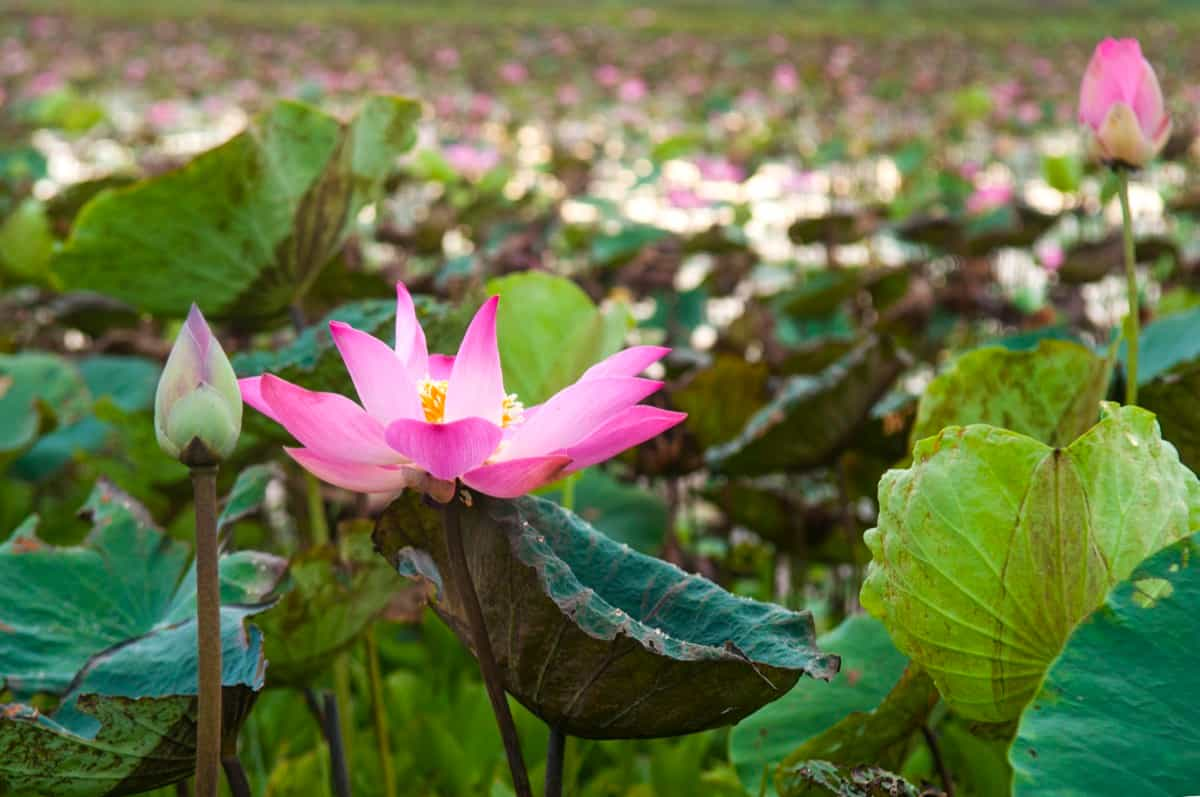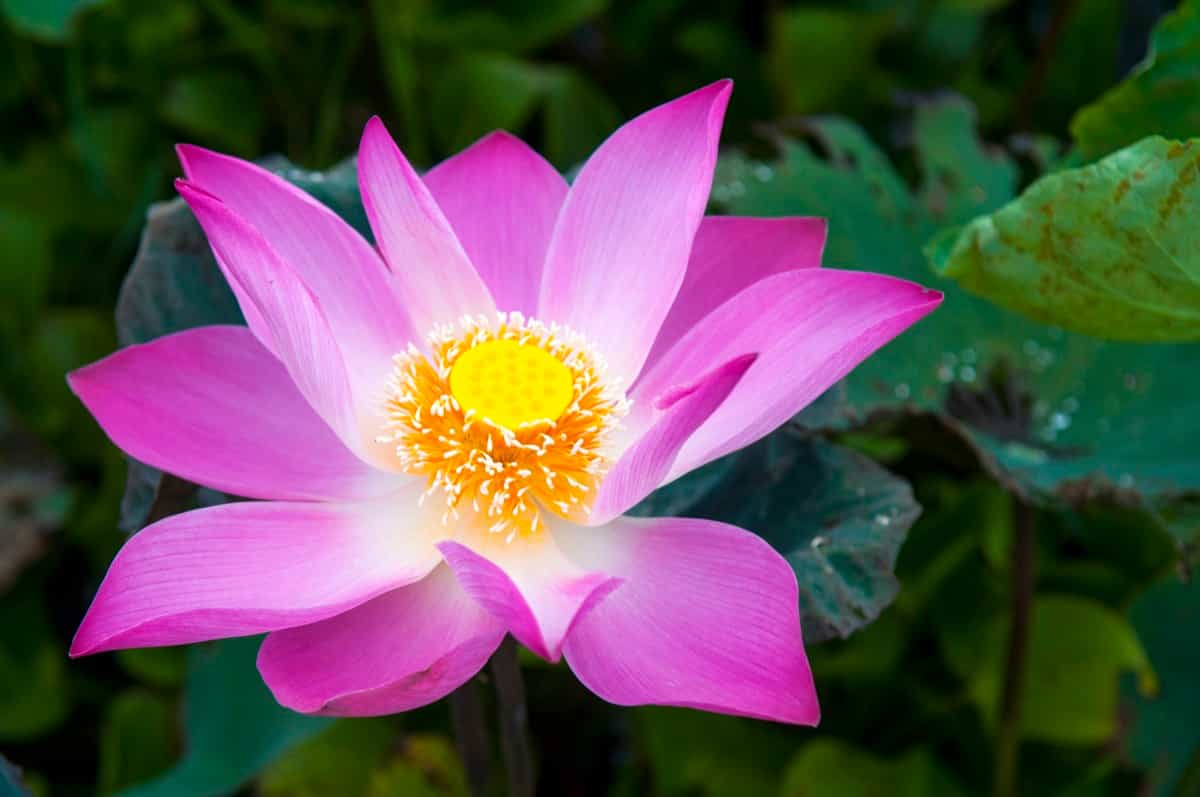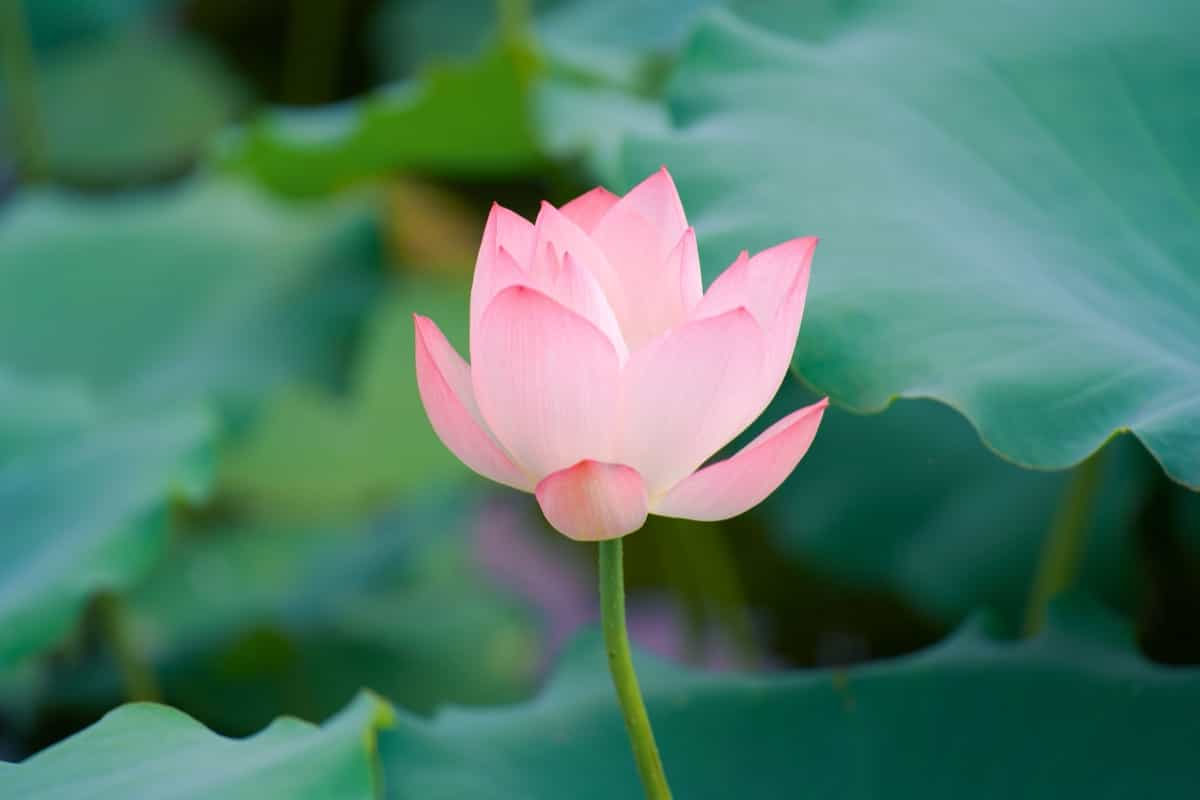Welcome to the ultimate guide to lotus cultivation, where we delve into everything you need to know about propagating, planting, growing, and caring for these exquisite water garden plants. Whether you’re a seasoned aquatic gardener or just starting, this comprehensive resource covers it all, from lotus pond setup to bloom enhancement and winterizing techniques.

Discover invaluable tips on fertilizing, pest control, disease management, and maximizing sunlight exposure for optimal growth. Dive into sustainable practices and container gardening options, and even explore the potential for profitable lotus cultivation.
Guide to Lotus Cultivation
Introduction to Lotus Cultivation
Lotus is a perennial aquatic plant in the Nelumbonaceae family, known for its large, round leaves and colorful flowers. Its cultivation has been practiced for thousands of years and is revered by various cultures for its beauty, symbolism, and medicinal properties. Lotus seeds and roots are edible and nutritious and can be grown in ponds, containers, or indoors with proper care.
The Significance of Lotus in Culture and Gardening
Lotus is more than just a pretty plant. It has a deep cultural, spiritual significance for many people around the world. Lotus is often associated with purity, enlightenment, rebirth, and wisdom. This is because lotus grows from the muddy bottom of the water and emerges as a clean and beautiful flower. Lotus is also a symbol of the sun, as it opens in the morning and closes at night.
Overview of Lotus Varieties: Choosing the Right One for Your Garden
There are numerous lotus varieties available in the market, each with unique characteristics such as size, color, shape, and blooming time. Some popular lotus varieties include dwarf lotus, bowl lotus, medium lotus, and large lotus. Dwarf lotus grow up to 1 foot tall and have 2 to 4-inch-wide flowers, ideal for small ponds or containers.
Bowl lotus grow up to 2 feet tall and have 4 to 6-inch-wide flowers, suitable for medium-sized containers or ponds. Medium lotus grow up to 3 feet tall and have 6 to 8-inch-wide flowers, ideal for large ponds or lakes. Large lotus grow up to 5 feet tall and have 8 to 12-inch-wide flowers, ideal for spacious ponds or lakes. When choosing a lotus variety, consider factors such as the size of your pond or container, the climate of your area, and your taste and style.
How to Propagate Lotus Cultivation
To grow a lotus plant in your garden, you need essential equipment and supplies. A pond or container should be at least 18 inches deep and have a surface area of at least 2 square feet per plant. A pot or basket should be made of plastic or metal mesh to allow water circulation and prevent soil erosion. A healthy lotus tuber with nodes or eyes on purchased from nurseries or online stores.
In case you missed it: Bolting Management in Plants: Prevention for Premature Flowers and Seeding in Crops and Vegetables

A soil mix rich in organic, such as compost, peat moss, or manure, should be used, as lotus plants prefer sandy or loamy soils. Fertilizers should be low in nitrogen and high in phosphorus and potassium, as lotus plants need more for blooming. Slow-release fertilizers formulated for aquatic plants, such as 10-26-10 or 5-10-5, or organic fertilizers like bone meal, fish emulsion, or seaweed extract, can be used.
Propagating Lotus Plants
Methods for Propagating Lotus: Seeds vs. Division
Seeds: Growing lotus plants from seeds can be an exciting and rewarding process. Here are some key steps to follow To grow Lotus seeds, create a small hole in the hard shell with a drill bit for water absorption and germination. Soak the seeds in water for 24 – 48 hours to soften the seed.
Fill a container with loam soil and aquatic plant fertilizer, plant seeds 1 inch deep and cover lightly. Place the container in a warm, well-lit area with a consistent temperature and water depth. Lotus seeds take 2 to 4 weeks to germinate, and after a few aerial leaves, fertilize them with an aquatic plant fertilizer.
Division: Dividing lotus plants is another common method of propagation. Here’s how to do it:
- Timing: The best time to divide lotus plants is in early spring when new growth begins.
- Preparing the plant: Carefully remove the lotus plant from its container or pond. Gently wash the soil to expose the rhizomes.
- Dividing the rhizomes: Use a sharp knife or shears to separate the rhizomes into sections. Each section should have at least one growing tip (eye) and a portion of the rhizome.
- Planting the divisions: Fill a container or pond with a suitable soil mix and place the divisions, with the growing tips facing up, about 2 inches deep in the soil. Ensure that the growing tips are slightly above the soil surface.
- Watering and care: Keep the soil moist and provide adequate sunlight. Once the divisions establish roots and new growth, you can start fertilizing them.
Tips for Successful Lotus Propagation
- Choose healthy and viable seeds or divisions for propagation.
- Maintain proper water temperature and quality for seed germination and division establishment.
- Provide adequate sunlight or artificial light for healthy growth.
- Use a suitable soil mix with good drainage for planting lotus seeds or divisions.
- Follow a regular fertilization schedule to provide essential nutrients for optimal growth.
- Monitor the lotus plants for signs of pests, diseases and take appropriate measures if needed.
- Be patient, as lotus plants may take some time to establish and reach maturity.
Winter Care for Lotus Plants
Preparing Your Lotus for Winter
- Trimming and cleaning: Before winter arrives, trim any dead or dying foliage from your lotus plants. This will help prevent the accumulation that can rot and cause issues during winter.
- Overwintering in containers: If you have lotus plants in containers, move the containers to a protected area, such as a garage or basement, where the temperature remains above freezing. Ensure plants receive adequate light during this period.
- Overwintering in ponds: If you have lotus plants in ponds, there are a few options for overwintering:
Deep water method: In regions with mild winters, you can leave the lotus plants in the pond and lower them to a deeper section where the water is less likely to freeze completely. This will provide some insulation and protection for the plants.
Tropical lotus method: In colder regions, you can treat lotus plants as tropical plants and remove them from the pond before the first frost. Trim the foliage and place the tubers in a container filled with water. Store the container in a cool, dark place with a temperature of 50-60°F (10-15°C). Check the tubers periodically for any rot or drying out.
Tuber storage method: Another option is to carefully dig up the tubers and store them in a container filled with peat moss. Store the container in a cool, dark place with a temperature between 35-45°F (2-7°C). Check the tubers regularly for any signs of rot or drying out.
In case you missed it: How to Make Flowers Bloom Faster: Naturally, Overnight, at Home, and in Water with Fertilizers

Overwintering Techniques for Different Climates
The specific overwintering techniques may vary depending on your climate and the severity of winter conditions. It’s important to consider the average winter temperatures and the hardiness of your lotus plant varieties. Consulting with local gardening experts or experienced lotus growers in your area can provide insights into the best overwintering practices for your specific region.
Troubleshooting Common Lotus Cultivation Issues
Yellowing Leaves: Yellowing leaves sign of nutrient deficiency, improper water conditions, or pest infestation. Ensure that your lotus plants receive adequate sunlight, proper fertilization, and appropriate water depth and quality. Address any nutrient deficiencies or pest issues promptly.
Rotting Tubers: Rotting tubers can occur due to excessive moisture or poor drainage. Make sure your lotus plants are not sitting in waterlogged soil or containers. Improve drainage by using a well-draining soil mix and providing proper water depth.
Other Concerns: Other concerns may include pests, such as aphids or snails, and diseases like fungal infections. Monitor your lotus plants regularly for any signs of pests or diseases. Implement appropriate organic or chemical control methods if necessary. Proper sanitation, hygiene practices, such as removing dead foliage and debris, can also help prevent issues.
Solutions and Preventive Measures
- Maintain proper water depth and quality for lotus plants.
- Provide adequate sunlight and temperature conditions.
- Follow a regular fertilization schedule using an aquatic plant fertilizer.
- Ensure good drainage to prevent waterlogging and rotting.
- Practice good sanitation and hygiene by removing dead foliage and debris.
- Avoid overwatering or underwatering your lotus plants.
- Seek advice from local gardening experts or experienced lotus growers for specific issues in your region.
Harvesting Lotus Seeds and Flowers
When and How to Harvest Lotus Seeds
Lotus seeds are ready for harvest when the pods turn brown and dry out. Cut them from the plant, place them in a dry, well-ventilated area, and gently break them open to collect the seeds. Store the seeds in a dry place until they’re ready for propagation or culinary use. This process may take a few weeks.
Tips for Cutting Lotus Flowers for Arrangements
- Choose lotus flowers that are fully open and in their prime bloom.
- Use sharp scissors or pruners to cut the flower stems at an angle, just above a leaf node.
- Immediately place the cut stems in a container filled with clean water.
- Remove any excess foliage or leaves.
- Change the water regularly to keep the flowers fresh and extend their vase life.
In case you missed it: How to Increase Flowering in Vegetables: Best Ways to Induce and Enhance Flower Set

Marketing Strategies for Lotus Flowers in India
Local markets: Explore selling lotus flowers at local markets, flower shops, or garden centers. Connect with local florists or event planners who may be interested in purchasing lotus flowers for arrangements or events.
Online platforms: Utilize online platforms and marketplaces to reach a wider audience. Create a website on social media page to showcase your lotus flowers and connect with potential customers. Consider partnering with online flower delivery services to expand your reach.
Wholesale and bulk orders: Establish relationships with wholesalers or retailers who specialize in flowers. Offer competitive pricing and quality products to attract bulk orders.
Specialty markets: Identify niche markets or specific events where lotus flowers may be in high demand, such as weddings, religious ceremonies, or cultural festivals. Target these markets and promote your lotus flowers accordingly.
Networking and collaborations: Collaborate with local florists, event planners, or garden enthusiasts to promote lotus flowers. Attend industry events, workshops, or trade shows to network with potential customers and build partnerships.
In case you missed it: How to Increase Flowering in Fruit Trees: Step-by-Step Guide for Beginners

Economics of Lotus Cultivation in India
The average scenario where a farmer plants 5,000 lotus plants on one acre and incurs an expenditure of Rs 27,500 (midpoint of Rs 25,000 to 30,000). With a yield of 1 lakh lotuses annually, at a minimum price of Rs 5 per lotus, the revenue would be Rs 5 lakh. Subtracting the expenditure from the revenue, the profit would be Rs 4,72,500.
| Factors | Data |
| Area | 1 acre |
| Number of plants | 5,000 to 6,000 |
| Total expenditure | Rs 25,000 to 30,000 |
| Yield per farmer | Approximately 1 lakh lotuses per year |
| Price per lotus | Minimum Rs 5, up to Rs 10 during festivals and exports |
| Revenue per year | At least Rs 5 lakh |
| Additional revenue sources | Rootstalks: Rs 40-50 per kg, Leaves: used for crafts, Seeds: used for sweets or medicines, Flowers: used for religious or decorative purposes |
In case you missed it: Easy Homemade Recipes for Garden Plants: Natural and Organic Fertilizer for Vegetables, Flowers, and Houseplants

Conclusion
Mastering lotus cultivation offers a myriad of benefits, from spiritual significance to economic opportunity. With proper propagation, planting, and care techniques, coupled with an understanding of costs and profit potential, enthusiasts can foster thriving lotus gardens that nourish both the soul and the pocketbook.
- Types of Pesticides Used in Agriculture: A Beginner’s Guide
- Economical Aquaculture: A Guide to Low-Budget Fish Farming
- 15 Common Planting Errors That Can Doom Your Fruit Trees
- How to Make Houseplants Bushy: Effective Tips and Ideas
- Innovative Strategies for Boosting Coconut Pollination and Yield
- Pollination Strategies for Maximum Pumpkin Yield
- The Complete Guide to Chicken Fattening: Strategies for Maximum Growth
- Natural Solutions for Tulip Problems: 100% Effective Remedies for Leaf and Bulb-Related Issues
- Revolutionizing Citrus Preservation: Towards a Healthier, Greener Future
- Natural Solutions for Peony Leaf and Flower Problems: 100% Effective Remedies
- Maximizing Profits with Avocado Contract Farming in India: A Comprehensive Guide
- Natural Solutions for Hydrangea Problems: 100% Effective Remedies for Leaf and Flowers
- The Ultimate Guide to Choosing the Perfect Foliage Friend: Bringing Life Indoors
- From Sunlight to Sustainability: 15 Ways to Use Solar Technology in Agriculture
- The Ultimate Guide to Dong Tao Chicken: Exploring from History to Raising
- The Eco-Friendly Makeover: How to Convert Your Unused Swimming Pool into a Fish Pond
- Mastering the Art of Delaware Chicken Farming: Essentials for Healthy Backyard Flocks
- 20 Best Homemade Fertilizers for Money Plant: DIY Recipes and Application Methods
- How to Craft a Comprehensive Free-Range Chicken Farming Business Plan
- Brighten Your Flock: Raising Easter Egger Chickens for Beauty and Bounty
- How to Optimize Your Poultry Egg Farm Business Plan with These Strategies
- Subsidy for Spirulina Cultivation: How Indian Government Schemes Encouraging Spirulina Farmers
- Ultimate Guide to Raising Dominique Chickens: Breeding, Feeding, Egg-Production, and Care
- Mastering the Art of Raising Jersey Giant Chickens: Care, Feeding, and More
- Ultimate Guide to Raising Legbar Chickens: Breeding, Farming Practices, Diet, Egg-Production
- How to Raise Welsummer Chickens: A Comprehensive Guide for Beginners
- How to Protect Indoor Plants in Winter: A Comprehensive Guide
- Ultimate Guide to Grow Bag Gardening: Tips, Tricks, and Planting Ideas for Urban Gardeners
- Guide to Lotus Cultivation: How to Propagate, Plant, Grow, Care, Cost, and Profit
- Agriculture Drone Subsidy Scheme: Government Kisan Subsidy, License, and How to Apply Online
- Ultimate Guide to Raising Araucana Chickens: Breed Profile, Farming Economics, Diet, and Care
- Bringing Hydroponics to Classroom: Importance, Benefits of Learning for School Students
- Ultimate Guide to Raising Polish Chickens: Breed Profile, Farming Economics, Diet, and Care
- Ultimate Guide to Raising Australorp Chickens: Profile, Farming Economics, Egg Production, Diet, and Care
- Silkie Chicken Farming: Raising Practices, Varieties, Egg Production, Diet, and Care
- Sussex Chicken Farming: Raising Practices, Varieties, Egg Production, Diet and Care